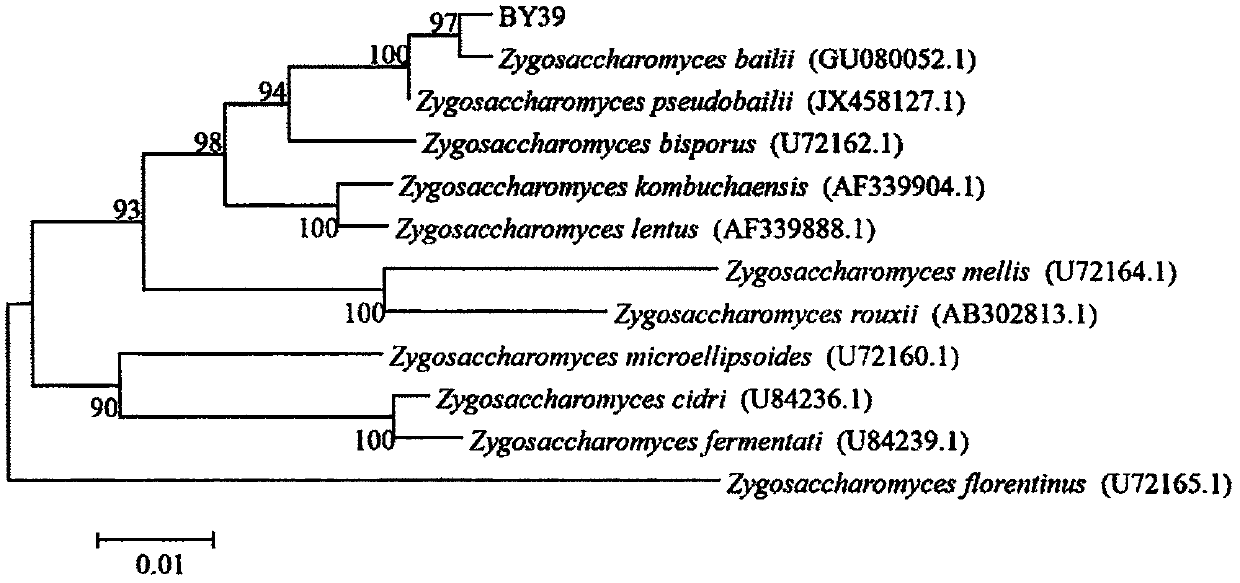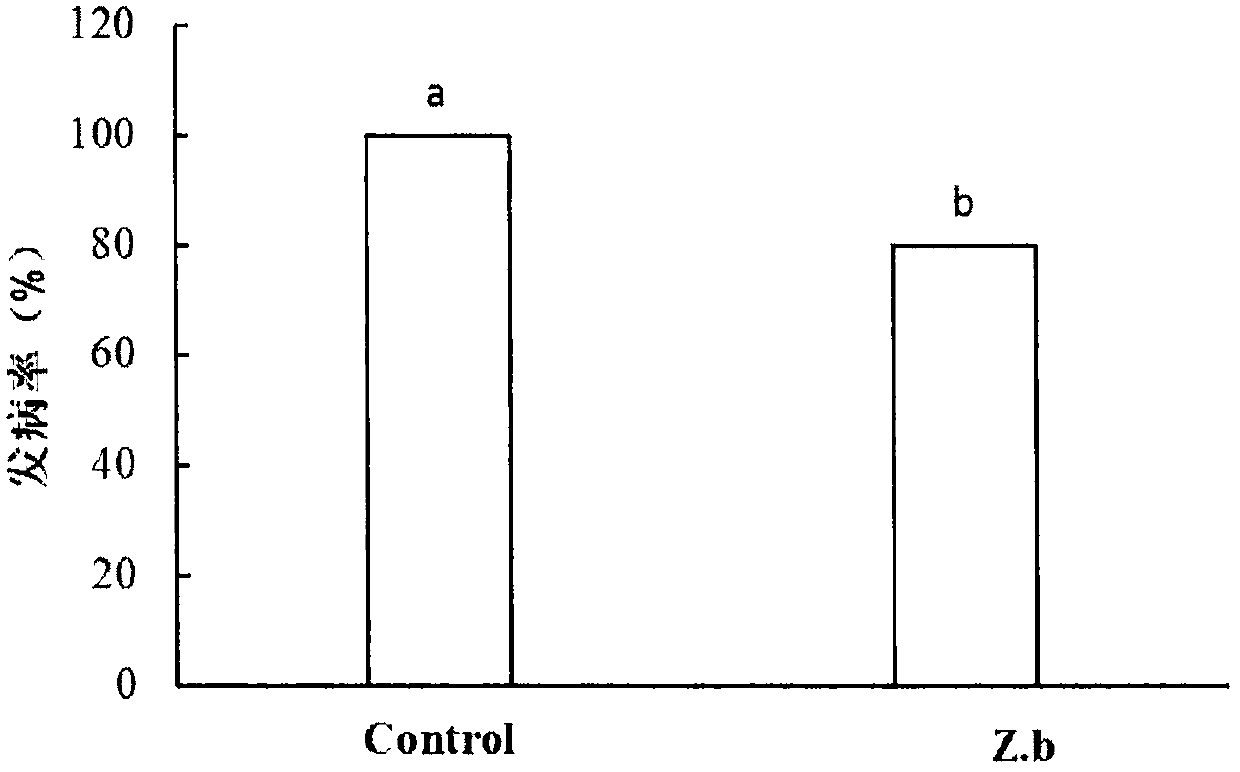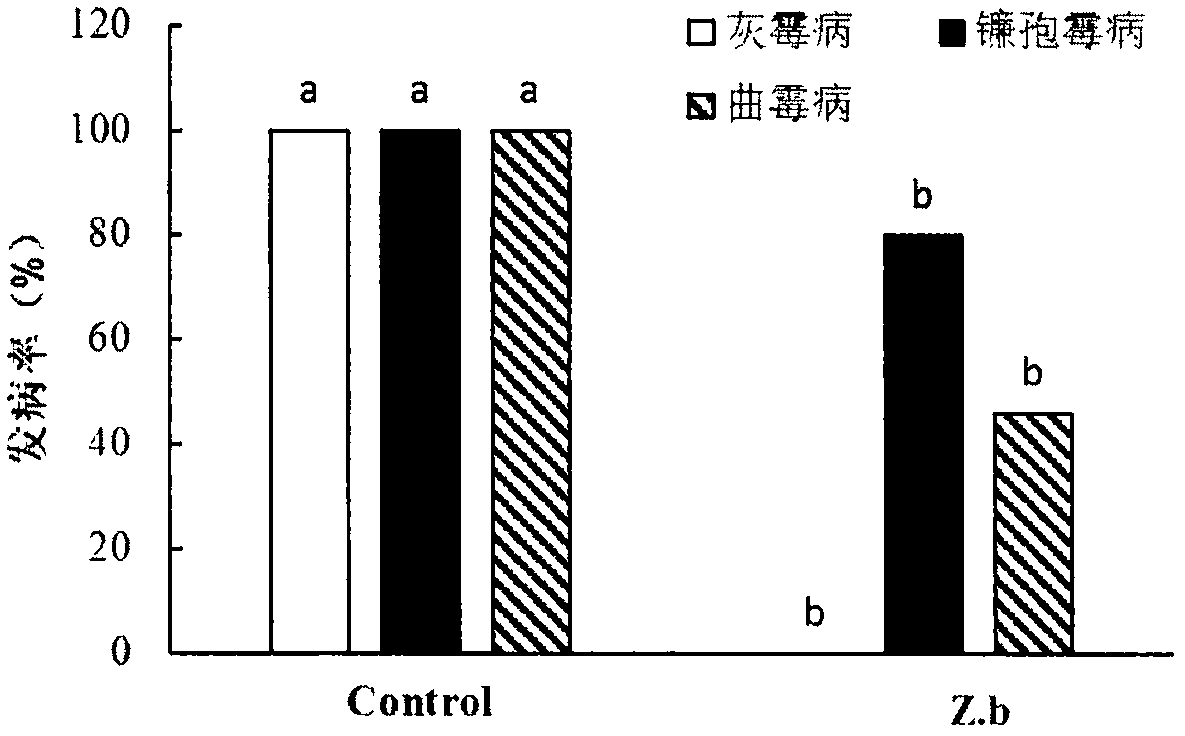Zygosaccharomyces bailii used for control of postharvest diseases of fruits and vegetables as well as preparation and application method thereof
A Bayer Zygomyces and postharvest disease technology, applied in the direction of microorganism-based methods, biochemical equipment and methods, and preservation of fruits and vegetables, can solve the problem that the biocontrol effect is only verified on a small number of fruits, and there is a lack of antibacterial spectrum strains, etc. problems, to achieve significant social and ecological benefits, stable properties, and a wide antibacterial spectrum
- Summary
- Abstract
- Description
- Claims
- Application Information
AI Technical Summary
Problems solved by technology
Method used
Image
Examples
Embodiment 1
[0018] Example 1: Biological characteristics of Zygosaccharomyces bailii strain BY39
[0019] 1. Morphological characteristics
[0020] (1) YPDA medium (yeast extract 1%, peptone 2%, glucose 2%, agar 1.8%, 121°C sterilization for 20 minutes) cultured at 26°C for 48h, the colonies were round and white, and the edges of the colonies were smooth and round. The cell shape is ellipsoid.
[0021] (2) After 24 hours of culturing in YPDA liquid medium, there is no formation of glutinous bacteria, the bacterial liquid is turbid, and there are sediments. Microscopically, the yeast cells are oval and budding.
[0022] 2. Molecular biology identification
[0023] Use universal forward primer NL-1 (5'-GCATATCAATAAGCGGAGGAAAAG-3') and reverse primer NL-4 (5'-GGTCCGTGTTTCAAGACGG-3') to PCR amplify the nucleic acid sequence of yeast 26S rDNA D1 / D2 region, and the PCR product The sequencing results are entered into the website www.NCBI.nlm.nih.gov for BLAST, homologous sequences are downloaded from th...
Embodiment 2
[0025] Example 2 The inhibitory effect of Bayer joint yeast BY39 on apple black spot
[0026] 1. Experimental protocol
[0027] Take out the Bayer joint yeast BY39 from the refrigerator at -80°C, activate it with YPDA medium (10g yeast extract, 20g peptone, 20g glucose, 18g agar, 1000ml deionized water, natural pH, sterilized at 121°C for 30min) and activate it. The colonies were placed in YPD liquid medium, cultured at 26°C, 200r / min for 24h, centrifuged at 4000rpm for 5min, discarded the supernatant, the collected bacteria were washed 3 times with sterile water, and counted on a hemocytometer to prepare the concentration 1×10 8 Cells / mL Bayer conjugative yeast BY39 bacterial suspension.
[0028] Activate Alternaria tenuissima on a PDA medium plate, culture it at 26℃ for 7 to 14 days, scrape appropriate amount of spores, and prepare the concentration with sterile water to 5×10 4 Cell / mL Alternaria spore suspension.
[0029] The healthy and undamaged apple fruit was sterilized with 2...
Embodiment 3
[0032] Example 3 The inhibitory effect of Bayer's joint yeast BY39 on grape disease after harvest
[0033] 1. Experimental protocol
[0034] Take out the Bayer joint yeast BY39 from the refrigerator at -80°C, activate it with YPDA medium (10g yeast extract, 20g peptone, 20g glucose, 18g agar, 1000ml deionized water, natural pH, sterilized at 121°C for 30min) and activate it. The colonies were placed in YPD liquid medium, cultured at 26°C, 200r / min for 24h, centrifuged at 4000rpm for 5min, discarded the supernatant, the collected bacteria were washed 3 times with sterile water, and counted on a hemocytometer to prepare the concentration 1×10 8 Cells / mL Bayer conjugative yeast BY39 bacterial suspension.
[0035] Activate Botrytis porri, Aspergillus aculeatus or Fusarium redolens on a PDA medium plate, culture for 7 to 14 days at 26℃, scrape appropriate amount of spores, and prepare with sterile water The concentration is 5×10 4 Cells / mL of a spore suspension of Botrytis cinerea, Aspe...
PUM
 Login to View More
Login to View More Abstract
Description
Claims
Application Information
 Login to View More
Login to View More - R&D
- Intellectual Property
- Life Sciences
- Materials
- Tech Scout
- Unparalleled Data Quality
- Higher Quality Content
- 60% Fewer Hallucinations
Browse by: Latest US Patents, China's latest patents, Technical Efficacy Thesaurus, Application Domain, Technology Topic, Popular Technical Reports.
© 2025 PatSnap. All rights reserved.Legal|Privacy policy|Modern Slavery Act Transparency Statement|Sitemap|About US| Contact US: help@patsnap.com



